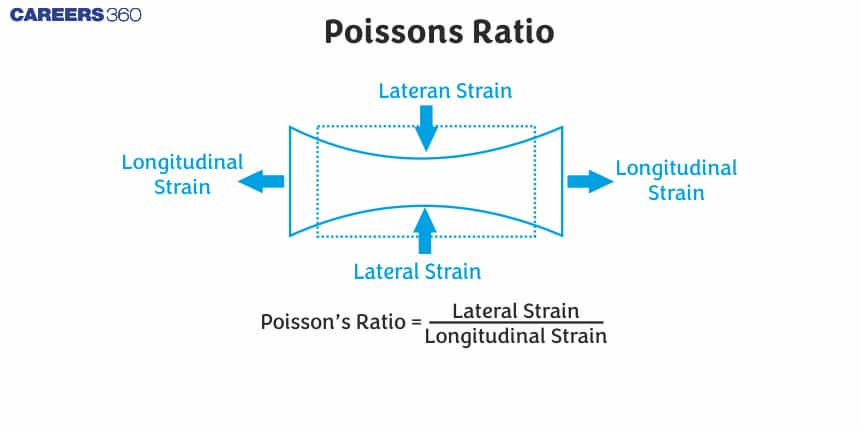Poissons Ratio - Definition, Formula, FAQs
Define Poissons Ratio
Poisson's ratio is the ratio of transversal expansion to axial compression, and it is symbolized by the Greek letter 'nu.' It is named after Simeon Poisson. The strain symbol is given by $\varepsilon$
What is Poisson's ratio?
“The ratio of transverse contraction strain to longitudinal extension strain in the direction of the stretching force,” as described by Poisson. Here,
-
Compressive deformation is regarded as negative.
-
Tensile deformation is regarded as a positive.
JEE Main/NEET 2027: Physics Important Formulas for Class 10
NEET 2025: Mock Test Series | Syllabus | High Scoring Topics | PYQs
JEE Main: Study Materials | High Scoring Topics | Preparation Guide
JEE Main: Syllabus | Sample Papers | Mock Tests | PYQs
- Define Poissons Ratio
- Poisson’s Formula
- The Poisson's Ratio

|
Symbol |
Greek letter ’nu’,v |
|
Formula |
Poisson’s ratio= -lateral strain/ Longitudinal strain |
|
Range |
-0.1 to +0.5 |
|
Unit |
Unitless |
|
Scalar/vector |
Scalar quantity |
Also read -
- NCERT Solutions for Class 11 Physics
- NCERT Solutions for Class 12 Physics
- NCERT Solutions for All Subjects
Poisson’s Formula
In the middle, it will compress. If the rubber's original length and width are L and B, respectively, it will tend to compress laterally when tugged longitudinally. To put it another way, the length has increased by dL and the breadth has increased by dB.
In this instance,
The Poisson ratio formula is as follows:
$$
\varepsilon_{\mathrm{t}}=-\mathrm{dB} \varepsilon_{/} / \mathrm{B}=-\mathrm{dL} / \mathrm{L}
$$
where,
- $\varepsilon_{\mathrm{t}}$ transverse strain
- $\varepsilon_i$ is the longitudinal strain
Poisson's ratio=Transverse Strain/Longitudinal Strain
The Poisson's Ratio
The change in dimension (length, breadth, area, etc.) divided by the original dimension is the strain.
Strain-
The term "strain" refers to how much an object has been stretched or deformed. When force is applied to an item, strain occurs. Strain is primarily concerned with the object's length change.
Lateral or transverse strain-
The ratio of the change in diameter of a circular bar of material owing to longitudinal deformation to its diameter is defined as lateral strain, also known as transverse strain. Because it is a ratio between two quantities of the same dimension, it is a dimensionless quantity. The lateral strain formula is given by the multiplication of the Poisson ratio and longitudinal strain.
Related Topics,
- Archimedes Principle
- Buoyant Force
- Bernoulli's Principle
- Density of Water
- Pascal Law and its Application
Longitudinal or axial strain-
A material elongates in the axial direction while contracting in the transverse direction when subjected to a tensile force P. Transverse strain is the contraction in the transverse direction, while a longitudinal strain is an elongation in the axial direction.
Poisson’s effect-
When a material is stretched in one direction, it compresses in the opposite direction, and vice versa. The Poisson's ratio is used to calculate the magnitude of this occurrence. When a rubber band is stretched, for example, it tends to get thinner.
Poisson’s ratio value for different materials-
It is the ratio of transverse contraction strain to longitudinal extension strain, in the direction of the stretching force. For tensile deformation, Poisson's ratio is positive. For compressive deformation, it is negative
-
Poisson's ratio is positive for tensile deformation.
-
It is negative for compressive deformation.
Despite the fact that the longitudinal strain is positive, the negative Poisson ratio indicates that the material will experience a positive transverse strain.
Range of Poisson's ratio-
For most materials, the Poisson's ratio is between 0 and 0.5.
For various materials, a few examples of the Poisson ratio are presented below-
| Material | Values |
| steel | 0.27- 0.30 |
| rubber | 0.4999 |
| concrete | 0.1-0.2 |
| clay | 0.30-0.45 |
| gold | 0.42-0.44 |
| cork | 0.0 |
| glass | 0.18-0.3 |
| copper | 0.33 |
| foam | 0.10-0.50 |
| stainless steel | 0.30-0.31 |
| cast iron | 0.21-0.26 |
Also, check-
- NCERT Exemplar Class 11th Physics Solutions
- NCERT Exemplar Class 12th Physics Solutions
- NCERT Exemplar Solutions for All Subjects
NCERT Physics Notes:
Frequently Asked Questions (FAQs)
Within elastic limits, Poisson's ratio for material is nearly constant.
In the direction of the stretching force, the ratio of transverse strain to longitudinal strain.
False. Poisson's ratio is positive for tensile deformation.
Concrete has a Poisson's ratio of 0.1 to 0.2.
A Poisson's ratio of 0.5 indicates that a fully incompressible material is elastically deformed at modest strains.
The unitless scalar quantity is Poisson's ratio.
Cork has a Poisson's ratio of 0.0.
Also Read
24 Dec'24 05:57 PM
16 Nov'24 11:39 AM
12 Nov'24 11:51 PM
12 Nov'24 09:36 PM
12 Nov'24 09:16 PM
11 Nov'24 07:25 PM
11 Nov'24 06:00 PM
05 Nov'24 07:02 AM
26 Sep'24 11:28 AM